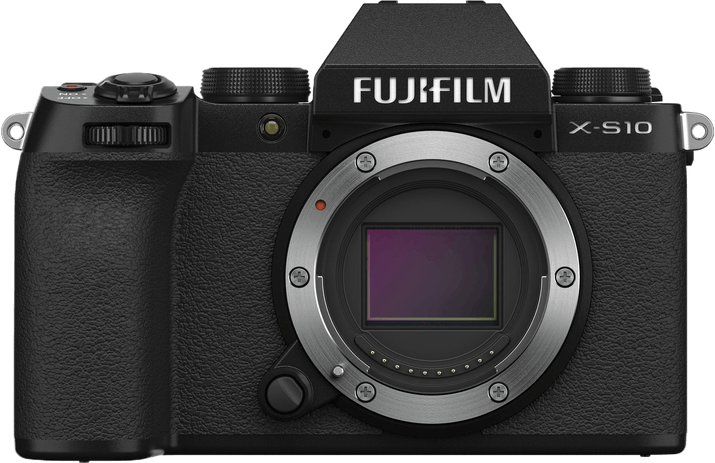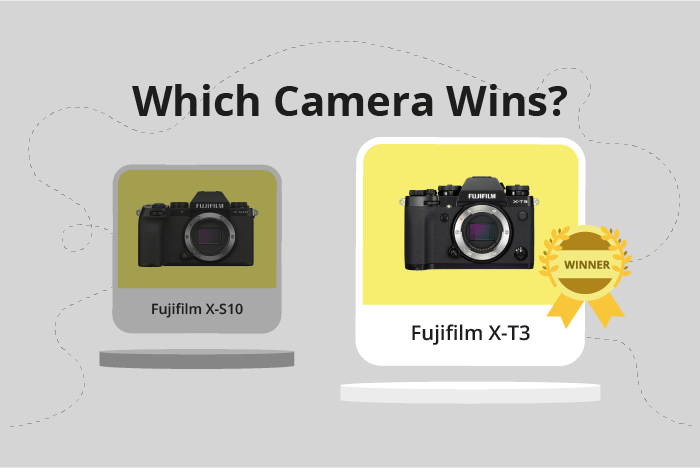Fujifilm X-S10 vs X-T3 Comparison
Fujifilm X-S10

Fujifilm X-T3

The Fujifilm X-T3 edges out the X-S10 with a score of 72/100 compared to 69/100. Both mirrorless cameras share similarities, such as their release years (2018 for X-T3 and 2020 for X-S10).
The X-T3 stands out with its smaller size (133 x 93 x 59mm) and lighter weight (539g), making it more portable and convenient for photographers. On the other hand, the X-S10 has a more compact design (126 x 85 x 65mm) but weighs more at 465g.
Despite its higher score, the X-T3 is older and generally more affordable. Each camera has its advantages, with the X-T3 offering a better overall performance and the X-S10 providing a more modern option.
Fujifilm X-S10 vs X-T3 Overview and Optics
The Fujifilm X-S10 outperforms the Fujifilm X-T3 in optics with a score of 72 out of 100, compared to the X-T3’s score of 67. Both cameras share several specifications, including 26-megapixel resolution, 20 frames per second shooting speed, CMOS sensor type, X-Processor 4, APS-C sensor size, and Fujifilm X lens mount. However, there are some differences that give the X-S10 an edge over the X-T3 in the optics department.
The primary advantage of the X-S10 is its built-in image stabilization. This feature allows photographers to capture sharper images in low-light conditions and helps reduce the effects of camera shake. In contrast, the X-T3 lacks image stabilization, which may result in less sharp images, especially when shooting handheld or in challenging lighting situations.
While the X-T3 does not excel in any particular aspect compared to the X-S10, it still offers solid performance with its shared specifications, such as the 26-megapixel resolution and 20 frames per second shooting speed. These features contribute to the overall quality of the images produced by the X-T3, making it a reliable choice for photographers seeking a camera with good optics.
Considering the similarities and differences between the Fujifilm X-S10 and X-T3, it is evident that the X-S10 has a slight advantage in optics due to its image stabilization feature. This makes it a better choice for photographers who prioritize image quality and stability. On the other hand, the X-T3 remains a viable option for those who value the shared specifications and do not require image stabilization.
Fujifilm X-S10 vs X-T3 Video Performance
The Fujifilm X-S10 outperforms the Fujifilm X-T3 in video capabilities with a score of 91/100 against the X-T3’s 83/100. Both cameras share common specifications such as 4K max video resolution, 4096 x 2160 max video dimensions, and built-in time-lapse functionality. However, the X-S10 surpasses the X-T3 in specific aspects, making it a better choice for video recording.
The Fujifilm X-S10 excels in its max video frame rate, offering 240fps compared to the X-T3’s 60fps. This higher frame rate allows for smoother slow-motion footage and provides more flexibility in post-production. The X-S10’s superior frame rate makes it an ideal choice for videographers who require high-quality slow-motion capabilities.
On the other hand, the Fujifilm X-T3 does not have any significant advantages over the X-S10 in terms of video capabilities. Its lower video score and frame rate make it less appealing for those prioritizing video performance. However, it is essential to consider other factors, such as budget and individual needs, when choosing between these two cameras.
The Fujifilm X-S10’s higher video score reflects its superiority in video performance, particularly in its max video frame rate. Videographers seeking smooth slow-motion footage and greater flexibility in post-production should opt for the X-S10. While the X-T3 may not offer any notable advantages in this area, it still delivers quality video capabilities for those who may not require the additional frame rate benefits. Ultimately, the choice between these two cameras will depend on individual preferences and priorities.
Fujifilm X-S10 vs X-T3 Features and Benefits
The Fujifilm X-T3 emerges as the winner in this comparison, with a feature score of 83/100, while the Fujifilm X-S10 trails behind with a score of 70/100. Both cameras share several specs, including a 3-inch screen size, 1040000-dot screen resolution, touchscreen, flip screen, and Bluetooth connectivity. Neither camera offers GPS functionality.
The X-T3’s superiority comes from its additional WiFi connectivity, a feature absent in the X-S10. This enables the X-T3 to transfer images wirelessly and connect to a smartphone or tablet for remote control, providing users with greater flexibility and ease of use.
On the other hand, the X-S10 does not surpass the X-T3 in any specific feature. However, it is worth noting that the X-S10 still offers a solid set of features, making it a suitable choice for photographers who may not require WiFi connectivity.
In comparing the Fujifilm X-S10 and X-T3, the X-T3 takes the lead due to its WiFi capabilities. This allows for a more convenient user experience and increased versatility in various photography situations. The X-S10, while not offering any advantages over the X-T3, remains a good option for those who can forgo the WiFi feature. Ultimately, the choice between these two cameras will depend on the individual photographer’s preferences and needs.
Fujifilm X-S10 vs X-T3 Storage and Battery
The Fujifilm X-T3 outperforms the Fujifilm X-S10 in storage and battery with a score of 68 to 35. Both cameras accept SD, SDHC, and SDXC memory cards, with the X-T3 being UHS-I compatible. Additionally, both cameras offer USB charging.
The X-T3 excels with two memory card slots, compared to the X-S10’s single slot. This provides more storage capacity and flexibility for photographers. The X-T3 also boasts a longer battery life, delivering 390 shots per charge, while the X-S10 provides 325 shots with its NP-126S battery.
The X-S10 does not have any advantages over the X-T3 in terms of storage and battery. Given these factors, the Fujifilm X-T3 is the superior choice for those prioritizing storage capacity and battery life.
Alternatives to the Fujifilm X-S10 and X-T3
Are you still undecided about which camera is right for you? Have a look at these popular comparisons that feature the Fujifilm X-S10 or the Fujifilm X-T3:

